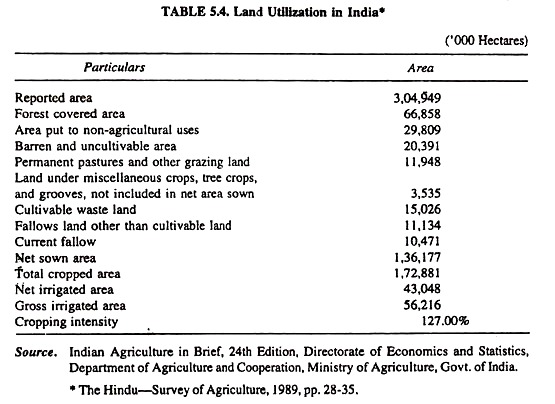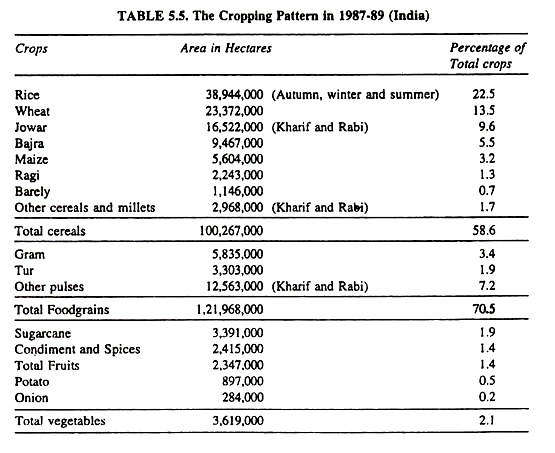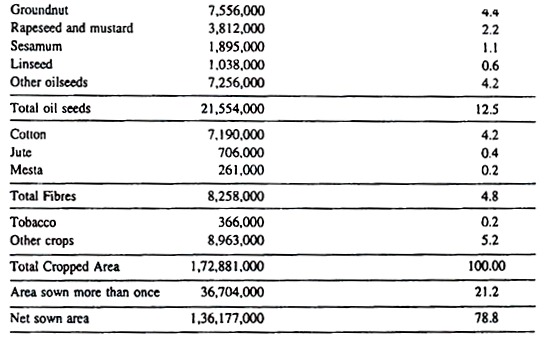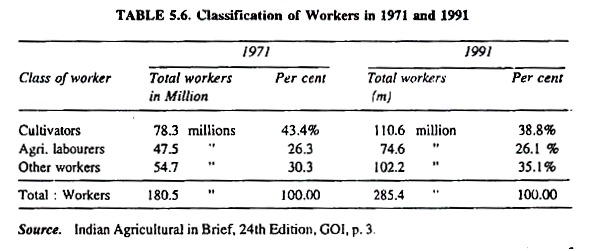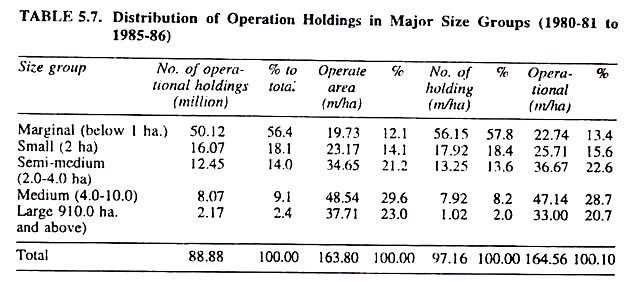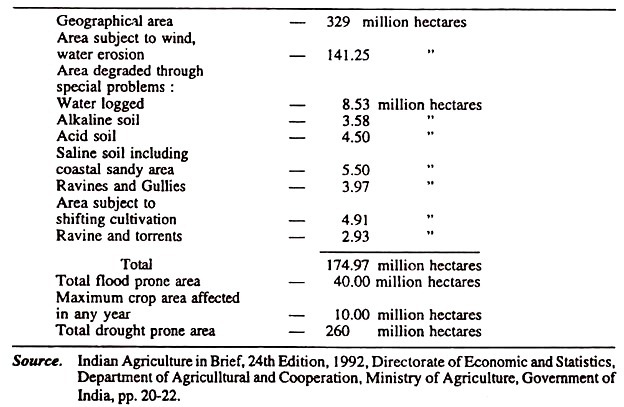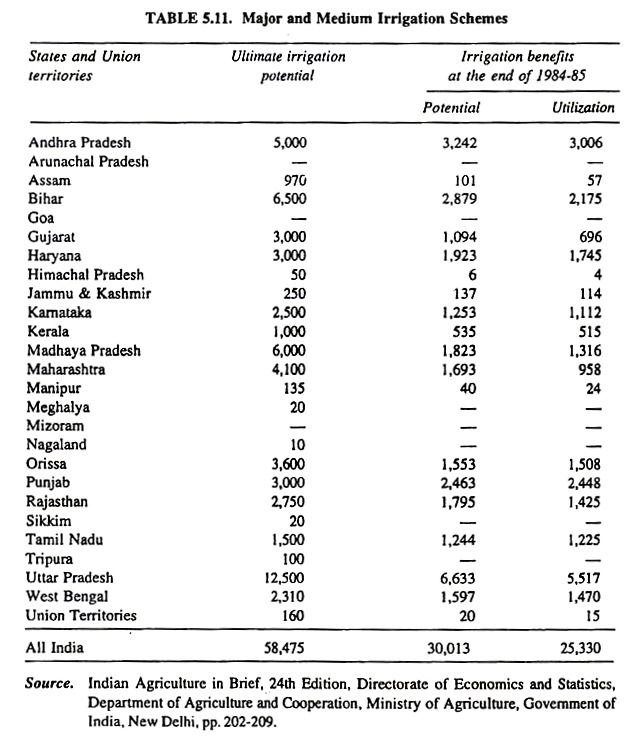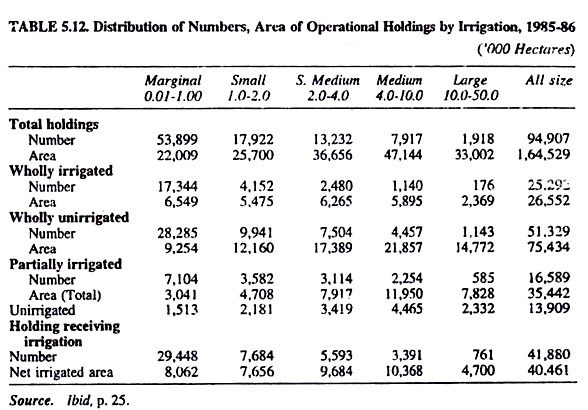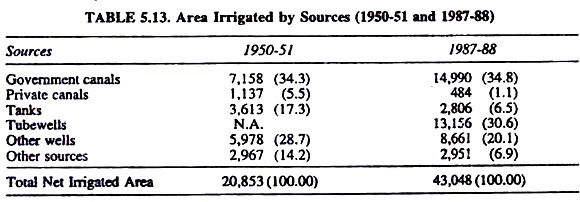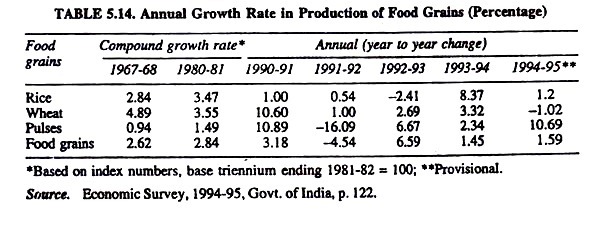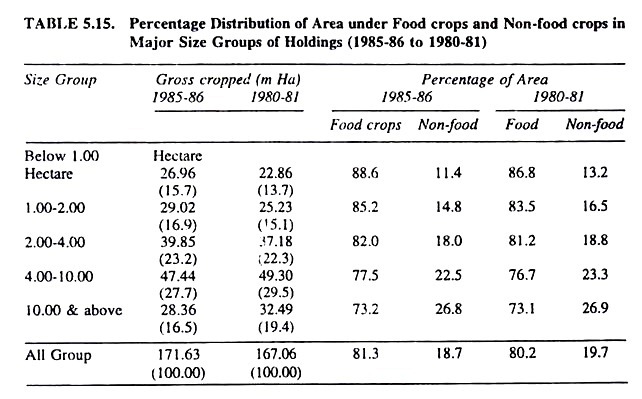After reading this article you will learn about the management of resources of a farm:- 1. Management of Land 2. Management of Problematic Soil 3. Irrigation 4. Labour 5. Machinery and Equipment.
Management of Land:
The concept of land is wide and according to Alfred Marshall leud is defined as “The material and the forces which nature gives freely for men’s aid, in land and water, in air and light and heat.” Land is a free gift of nature to mankind and it is the duty of the individual to make the best use of the God’s gifted asset to the best welfare of mankind as a whole in His praise.
Land is classified according to its capability in various uses. Agricultural land is classified based on fertility of the arable land on “anawari” basis or system as 100 per cent fertile as first grade land, 75 per cent as second grade, 50 per cent fertility as third grade land, and 25 per cent fertility as fourth grade land. Now, the country as a whole has been classified into fifteen classes according to the agro-climatic characteristics.
They are:
1. Western Himalayan region,
2. Eastern Himalayan region,
3. Lower Gangetic plains,
4. Middle Gangetic plain,
5. Upper Gangetic plain,
6. Trans Gangetic plain,
7. Eastern Plateau and Hills,
8. Central Plateau and Hills,
9. Western Plateau and Hills,
10. Southern Plateau and Hills,
11. East Coast plain and Hills,
12. West Coast plains and Ghats,
13. Gujarat Plains and hills,
14. Western Dry region,
15. Island regions.
This classification is based on the agro-climatic characteristics, involves a more scientific utilization of available natural and man-made in macro and micro zones through a system approach.
This is based on the criteria of homogeneity in agro-characteristics such as rainfall, temperature, soil topography, cropping and farming systems and water resources. This will facilitate the exploration of the natural resources to its full potentiality by the farming community of each region.
The above table reveals what is the status of cropping pattern in the country and we see that the area under fruits and vegetables are miserably low, therefore, efforts must be directed to increase area under the cultivation of such crops to bring diversification in our cropping pattern.
The role of fruits and vegetables are Very important in the present day context i.e., globalization of the Indian economy. Food security now a days is the hot topic of discussion. The government should do her best to help the agricultural sector for strengthening the food security.
When we compare the 1987-88 condition with 1990-91 in food grain output we feel that much progress has been made in food production despite certain obstacles in terms of unfavorable weather conditions and other constraints. The pressure of population on land is intense.
The population of workers in rural areas is given in the following table:
Due to the pressure of population in agriculture on account of the law of inheritance there will be further split in the holdings resulting into more diminutive size per family. The table below gives the distribution.
Within a period of five years there has been an increase in the number of operational holdings of marginal, small and semi-medium size farms but decrease in medium and large sized holdings which indicates the emergence of small farms.
This tendency will go on increasing. Thus, the responsibility of management of such farms by the fanners will be more acute within the land scarcity with the adoption of modern technology and use of inputs.
When planning the crop production within the given environment conditions, in accordance to agro-climatic conditions, it is necessary to prepare a map of the farm.
An inventory of the size, shape, topography of the soil, its fertility level and suitability to crops along with sources of irrigation and drainage facilitate be prepared. In addition previous years cropping scheme and the soil conservation practices adopted should be mentioned.
Taking into consideration the business point of view the farmer should decide what would be his objectives whether he would like to raise cash crops, or food crops or take to mixed farming. In the case of first two objectives he must study the demand and prices of inputs and output. In case of mixed farming then the balance between the crops and livestock will be the prime consideration.
If it is a livestock farm his objectives will be quite different and instead he would put land under the fodder crops. Here too the farmer will keep in mind the market and the prices of animals and their products. He must also consider the economy in terms of raising the feed and fodder or buying them from the market.
Again, the farmer must think of the principles of comparative advantages between or amongst the crops raised, of course, as per needs. Firstly, a rotation for a long period should be prepared. For each crop Cost and Returns be worked out.
Management of Problematic Soil:
In farming one has to keep his eyes open to see if there is any problematic soil, natural or by mismanagement. There are different kinds of problematic soils – viz., water logged, alkaline, acidic, saline, with sandy patches, ravine, gully, eroded soil.
The following table gives the extend of problematic soils in India (1984-85):
1. Waterlogged Area:
Waterlogged area does not command any use for agricultural purposes unless reclaimed. This becomes a collective responsibility of the villagers as a whole but in case of individual fanners proper drainage system would help reclamation and afterwards filling the soil and leveling it.
2. Acidic and Alkali Soil:
The pH value of the soil determines the crop which could be cultivated in that soil determining the soil reaction—acidity or alkalinity. The pH scale has a neutral value which is 7.0 below this are acidic soil and above this alkaline soil. The regions which get high rainfall have acidic soil but under arid conditions the soil becomes alkaline.
The quick method is the use of litmus paper which if soaked in soil moisture—if pink or reddish it shows acidity less pink less acid, dark pink high acidity. In case the litmus becomes blue it show the alkaline conditions, depending on the intensity of colour.
The treatment of acidic soil is done by the application of lime in the form of limestone, burned or hydrated lime, basic slag (from furnaces). The acid tolerant crops are: watermelon, lobia, strawberry, soybean, turnips, plantain, and ordinary beans.
The alkalinity is caused by sulphates and chlorides of alkali. There are two types of alkaline soils—while alkaline soil with white crustacean caused by evaporation of water from the soil. The other is black alkali soil which is caused by the presence of carbonates of sodium which dissolves organic matter which gives black colour and causes hard pan on the soil surface.
Alkali soil is reclaimed by physical, chemical and biological methods. The physical methods comprises of scrapping the surface soil, flooding the field, developing proper drainage system, deep ploughing, filling soil with sufficient organic matter.
The chemical method is by the application of chemicals like pyrite, gypsum.
The Biological method:
Planting of trees and crops which suck the alkaline salts and are tolerant to alkalinity as well as ploughing into the soils crops like sunflower, dhaincha etc.
3. Eroded Soil:
Soil erosion is the removal of fertile soil from the soil surface. There are two types of erosion: Wind and Water erosion. Water erosions are of two types—sheet erosion which is caused by flood water which flow with velocity and removes the finer particles of the soil rich in organic matter and chemicals causing nutrient deficiency in the soil.
The other is the gully erosion which is caused by the flow of water with great velocity resulting in first fingerlings and later as gully which may be deep in nature thus making the land uncultivable.
The check and reclamation of erosion is done: Sheet erosion is checked by land coverage with crops which have a binding deep root system, terrace farming in hilly regions checking the velocity of water flow by planting crop across the slope. Gallery erosion is checked by controlling the velocity of water by building dams, counter bunds etc.
Wind erosion also removes finer soil particles with wind and this could be checked by building wind breaks across the land checking the wind velocity. Soil fertility is also affected by the coverage of fertile soil with sand and other infertile materials known as sand dunes.
Another cause may be the weed infestation. Weeds could be eradicated by physical—turning weeds into the soil with the help of soil turning plough and disc plough which kills the weeds. The chemical control of weeds is by the use of weedicides like 4D, etc.. The biological control is through the insects like colchine or plant parasites. Better tillage practices removes weeds.
Besides, killing weeds, the proper tillage practices help in giving proper chemical reaction like oxidation, nitrification and also improves the physical properties of soil like proper soil aeration, increase in water holding capacity, encouragement of useful soil microorganisms, soil heat is incorporated.
Likewise, adding organic matter into the soil by practising green manuring as well as good rotation is highly beneficial in maintaining good fertility of physical, chemical and biological nature.
Management of Irrigation:
Water is commonly taken for granted as nature’s gift. Often it is used wastefully in agriculture, but industry and people pollute and poison available water supplies at an alarming rate. In the field of agriculture water is needed for additional food production. Injudicious use of water for irrigation depletes it supply affecting sustainability.
Tanks meant for irrigation number as five lakhs in India and are shrinking due to siltation and encroachment. A highly efficient and irrigation cropping can bring sustainability. The country’s irrigation potentiality has increased from 22.6 Million hectares in the pre-plan period to about 90 million hectares at the end of 1996-97. The utilization is a little lower in relation to potential.
Irrigation is a fixed asset as applied in different forms and amounts. Irrigation obeys the law of diminishing returns and therefore the principles of marginal cost and marginal revenue applies to its use for a farmer with limited capital. The principles of allocating water between hectares according to the marginal productivity principles applies where only a limited supply of water is available.
Irrigation water come from different sources in India such as canal, State and private tube-wells, river ponds, ditches, masonry wells and reservoirs and dams. Water management is a very important exercise for the farm manager where there is a dry land irrigation.
If irrigation is skillfully handled, it means perfect soil-water-fertilizer-seed balances. In case of canal irrigation in Uttar Pradesh excessive water may be used, as the charges for canal water use is fixed, which may cause damage to soil turning it into alkaline condition.
Water must not run over the soil with too great a force or rate otherwise erosion of fertile soil may take place. The quality of water available and soil climate conditions decide the method of application of irrigation water in arid regions with less water sprinkler irrigation is advised, drip irrigation system is also effective.
Slow application should be practiced on sloppy land to allow water to be absorbed by the soil and then plant.
Proper drainage system is important to check the harmful effect of unwanted salts in the irrigation water which might also eventually ruin the soil condition resulting in sick spots. In dry land cultivation bacteria fix nitrogen from air at rate rapid enough to support crop yields consisted with rainfall. Addition of irrigation water changes the balance thus nitrogen ordinarily must be added at a greater rate for economic efficiency.
Arid soil do not leach so phosphate (PO4), K7, Ca are not lacking but soil test may be done to check upon any deficiency. The rate of application of irrigation water depends on many factors: alkalinity, soil texture and structure, the morphology and physiology of crops, the climate, the method of application and irrigation preparation.
The quantity of water applied depends on fixed cost or water, labour or in case water is a variable cost then added marginal cost and marginal returns must be deciding the equation. Under these conditions, and with rapidly diminishing returns, it seldom pays to apply enough irrigation water to get maximum per hectare yield.
If farmers own sufficient capital and labour but water is limited to an extent of fixed cost then the principle of opportunity cost be considered in allocating water to hectares.
If water is applied to several crops, the opportunity cost principle be used, but must consider the price as well as the yield of crops. In case capital and labour are limited resources and water ample resource then again opportunity cost principle be applied for figuring how much water is to be used and the levels of yields to attain.
Here the opportunity cost is built around capital and labour not around water. In order to cultivate high value crops the farmer must invest in irrigation resources. Timely irrigation rather than the quantity of irrigation is more important.
The most profitable rates or depths at which to apply water obviously will depend on the fertilization plan, seed rate, soil conditions— texture and structure, depth of soil, nature of crops and its root system.
Investment in irrigation development again under limited and unlimited conditions depend the application of opportunity cost principle and added cost and added returns principles respectively. If the discounted income seems to be sufficiently high for interest costs and risks involved in long term investment need to be discounted.
After deciding upon the farmer, with limited capital, must decide whether to borrow capital or not. Another important condition is the extent to which irrigation could reduce the variability or uncertainty of income but it should not be at low level.
Introduction of assured irrigation on the farm will definitely necessitate to bring change in the farming system and the principles of using resources could be done efficiently through partial budgeting.
After considering several plans with budget it should be made out for long run price expectation. In the initial years the income will be less but later will go up. In case of the break in rainfall supplementary irrigation is needed and it should be well planned.
There are a number of multi-purpose and major irrigation projects in different states which are given as follows:
Andhra Pradesh-12, Assam-2, Bihar-15, Goa-1, Gujarat-9, Haryana-7, Himachal Pradesh-1, Jammu and Kashmir-1, Karnataka -13, Kerala-12, Madhya Pradesh-19, Maharashtra-36, Manipur-3, Orissa-4, Punjab-2, Rajasthan-6, Tamil Nadu-2, Uttar Pradesh-24, West Bengal-3, Dadra & Nagarhaveli-1, Daman & Diu-1. Total for all States is 174.
The ultimate irrigation potential and irrigation benefits and utilization State-wise and Union Territory wise is given the following table:
The farmers have become conscious of having an assured source of irrigation because there is a change in the cropping pattern for more profitable crops or high value crops, particularly cereals, cash crops, fruits and vegetables. There is an increase in government canals, tube-wells, and other wells both in terms of number and size whereas tanks and private canals are reduced considerably.
The following table gives the Annual Growth Rate in Production of Food grains:
Management of Labour:
Labour efficiency on farm refers to the amount of productive work accomplished per man on the farm. In general, higher the labour efficiency, greater are the returns from farming. Thus, labour is the largest contributor to farm income. Higher labour efficiency increases farm returns in all areas and under all types of economic conditions.
Efficiency in the use of man labour on farms, however, is specially important in periods of high prices and in areas and periods of high labour costs. In such cases farm labour must be used at maximum efficiency if earnings are to be maintained at the reasonable level.
The size of farm business and labour efficiency are somewhat interrelated in relationship to farm returns. An adequate size of business usually results in greater efficiency in the use of man labour on the farm. To the extent the size affects efficiency in the use of labour, labour efficiency can be considered a result rather than a cause and is not a primary factor affecting farm returns.
However, labour efficiency is not completely a result of size. To the extent/such efficiency/that is achieved independent of the size of business, it is an important cause of variation in farm returns. “The real cost of labour for one job is the return it can make if used on other jobs, either on or off the farm.”
Factors affecting labour efficiency in Agriculture:
1. How crop and livestock are combined?
2. Farm-stead and field layout.
3. Planning of farm workers.
4. Utilization of machinery and equipment’s by the labour.
5. Management and supervision of labour.
To achieve labour efficiency there should be a two pronged approach:
(a) The inherent qualities of labour, the skill, education, racial inheritance, health, desire and willingness to work, and sincerity to employer and the work (job),
(b) The utilization of labour force by the management through the use of the above five factors as well as the treatment meted out to the labour for their larger welfare, for instance, adoption of minimum wages.
For the better utilization of labour farm manager uses the following:
1. Enterprise Combination:
In case the labour is used on specialized farm where cultivation is seasonal it become difficult to fully utilize the existing labour force as the labour will remain idle in the lean period. This is particularly applicable in case of permanent hired labour and family labour. It is, therefore, necessary to diversify production.
It is advisable to raise more crops which demand labour at different part of the year, also use labour on different crops grown in the same season, for example, paddy, soybean, large millets, (Jowar, Bajra and Maize).
Thus, diversification is one way to obtain fuller utilization of labour. But some enterprises are competitive and require labour simultaneously, therefore, supplementary enterprises should be combined to “even out” labour requirements.
Adding supplementary enterprises may add less to income then expanding the main enterprises with a poorer seasonal distribution of labour once the main profit enterprise or enterprises are selected, whether to add supplementary enterprises or expand the main enterprise is decided by their relative returns and risks.
2. Field and Farmstead Layout:
Farmstead layout is useful in saving time and efforts to reach plots of field. Layout of the field in terms of size and shape as well as convenient approaches to them not only bring labour efficiency but also machinery and equipment’s efficiency is increased.
The farm buildings should be closer to each other. Entire overhauling of buildings in construction will be costly thus minor changes should be made in arrangements of buildings.
Poor management wastes labour for efficient use of labour, work must be planned:
1. Never do off season work in season—like machinery equipment repairs be undertaken in the lean period.
2. Preparing daily or weekly work plan or schedule. Differentiate between skilled and unskilled labour, efficient workers and inefficient workers.
3. The daily and weekly plan which are prepared should be flexible, for instance, if it suddenly rains keep the labour under the shade to do repair works or making ropes etc. as the land or field will be unfit for any operational work like ploughing or on a windy day spraying and dusting is postponed for a calm day and instead indoor work may be undertaken.
4. Study, analyze or routinize job to reduce waste motion and energy.
5. On farm training of workers like in handling the machinery or equipment, mixing of fertilizers or handling the spraying and dusting equipment.
6. Give incentives to workers of the farm, like promotions, housing, medical facilities or vocational training which adds to their welfare.
Management of Machinery and Equipment:
With the development of technology in agriculture and mechanization of agriculture there must naturally be an increase in demand for machinery and equipment. With increasing constraints in land resources multiple cropping is being practiced if the other supporting inputs like irrigation is available in assured form the use of machinery become an essential input to manage the timely operations in the field.
With the increasing use of high yielding varieties of crops the mechanized irrigation and plant protection application and mechanized harvesting is an important requirement. The farms have varied resource endowment and, therefore, the economic efficiency in respect of decision vary from farm to farm, that is, depending on the size of farm business, financial resources, and labour supply.
Machine costs:
There are two distinct cost which make the total cost of machinery and equipment, they are:
1. Fixed cost,
2. Variable cost.
The nature of fixed cost is that it is there irrespective of the scale of production. These are known as constant cost. The fixed cost comprises of Insurance cost for tractors and other heavy machinery, depreciation, obsolescence, interest, housing and if there are any taxes.
The other cost is variable cost. This cost varies with the scale of production or business and is proportional to it. This cost varies with the machinery use. The variable costs involved with the machine and equipment are: fuel or gasoline cost, lubrication, tyres and tubes, parts that wear and tear, accessories, labour cost, repair and maintenance.
Owning machine costs, therefore, which cost should be taken into consideration. It is thus, the additional or marginal costs for machine should be considered when making decisions on machinery investment. These additional costs are: the ones which occur if the machine is purchased. These are:
Fuel and lubricants but not the fixed cost of the machinery already at hand because they are already incurred, for example, if bullock drawn implements are purchased, the cost of feeding bullocks are not taken as added cost because the bullocks have to be fed whether the implement is purchased or not, although if extra feed is given to bullocks to draw the implement then it would be an added cost.
Machine repairs, depreciation due to annual use and time, repairs, obsolecscenous, taxes. If more housing is needed for the purchased machinery or equipment then it is added cost, Insurance, Labour, if hired on account of added machine, Involvement of family labour, Interest on machinery investment.
Another question is the rate at which the costs are to be charged. This depends on the physical condition of the farm land.
Interest rate is another which is borrowed, if the farmer invests his own money the interest will be charged at the market rate of interest.
In case the farmer has a limited fund then the opportunity cost basis is used for calculation of cost.
Which machine to own? The owning of machine needs a wise decision because it involves high investment, therefore, the following points should be kept in mind:
1. Machine with high annual use.
2. Machine with low initial investment, the charges are at per hectare cost (excluding power and labour).
3. Machine providing timeliness of operation—some farm operations are required to be performed in time as in the case of multiple farming system because timely operations in between the two crops is important. In India the farm size (holdings) are very small, the overwhelming majority comprises of small and marginal farmers.
In such cases the full utilization of machinery and equipment is not possible on the owner’s farm so custom hiring becomes necessary for the full utilization of machines and equipment.
Size of Machinery to Own:
The decision to own a particular size of machinery depends on the conditions which vary from farm to farm in terms of other resources such as labour, capital availability, system and type of farming etc.
1. In case of large farms where labour is scarce input it is advisable to purchase a big size machine as it will save on labour but at the same time the cost of labour saved should be compared with the cost of owning the machinery.
The key points when considering these guides are:
1. The difference between the first cost of large and small machinery.
2. The annual use to be made of machine.
3. The amount of labour saved by the large machine.
4. The relative value of labour and capital on the farm.
The reasons attributed are:
If the cost difference is high then the fixed cost would be enormous and would not offset by the labour saved. If the difference is less then it will be offset by labour saved.
The annual use of the fixed cost of machine will be spread over and will be less per unit of operation.
The two factors—labour and capital saved are very important consideration as these two vary from to farm.
Those having large machine is advantageous one:
(a) Where labour supply is limited,
(b) Abundant capital is available,
(c) Machines have high annual use.
For economic use of power, machine size must be adjusted to the size of power unit available.
